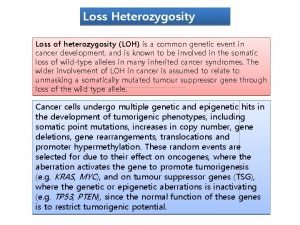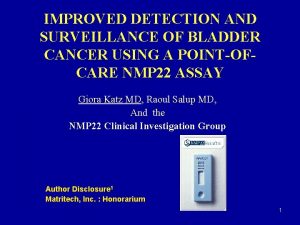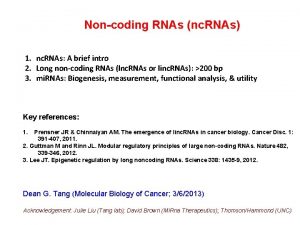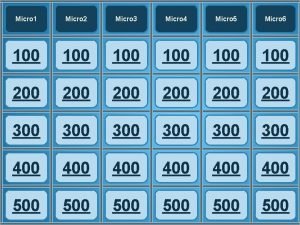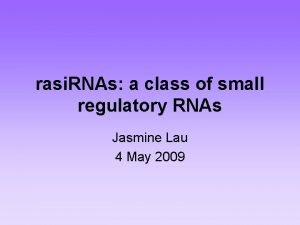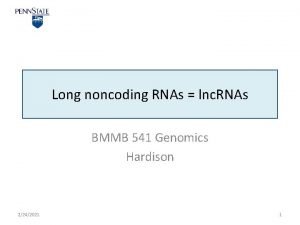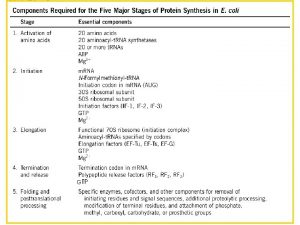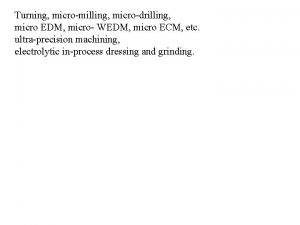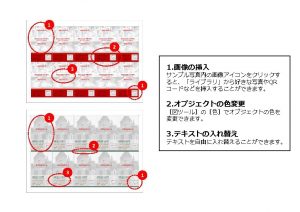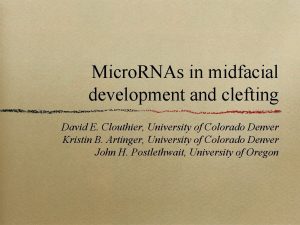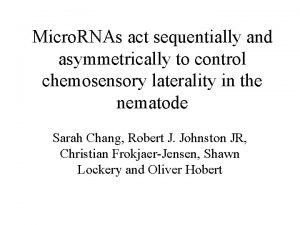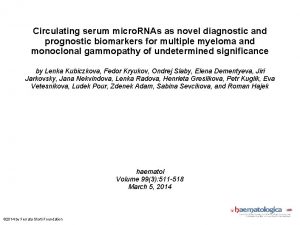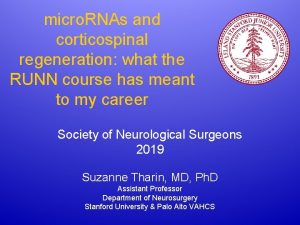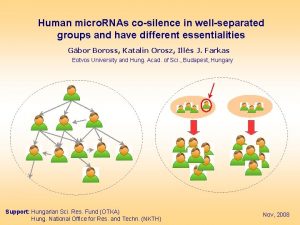V 10 micro RNAs and cancer What are




























- Slides: 28

V 10: micro. RNAs and cancer What are micro. RNAs? … How can one identify micro. RNAs? What is the function of micro. RNAs? How are micro. RNAs related to cancerogenesis? Can one use micro. RNAs as biomarkers for cancerogenesis? SS 2013 - lecture 10 Modeling of Cell Fate 1

RNA world short name full name m. RNA, r. RNA, t. RNA, function you know them well. . . oligomerization Single-stranded sn. RNA sno. RNA small nuclear RNA small nucleolar RNA splicing and other functions nucleotide modification of RNAs Long nc. RNA Long noncoding RNA various mi. RNA micro. RNA gene regulation single-stranded si. RNA small interfering RNA gene regulation double-stranded SS 2013 - lecture 10 Modeling of Cell Fate 2

RNA structure Also single stranded RNA molecules frequently adopt a specific tertiary structure. The scaffold for this structure is provided by secondary structural elements which are H-bonds within the molecule. This leads to several recognizable "domains" of secondary structure like hairpin loops, bulges and internal loops. RNA hairpin 2 RLU Stem loop 1 NZ 1 www. rcsb. org SS 2013 - lecture 10 Biological Sequence Analysis 3

sn. RNAs Small nuclear RNA (sn. RNA) are found within the nucleus of eukaryotic cells. They are transcribed by RNA polymerase II or RNA polymerase III and are involved in a variety of important processes such as - RNA splicing, - regulation of transcription factors or RNA polymerase II, and - maintaining the telomeres. They are always associated with specific proteins. The complexes are referred to as small nuclear ribonucleoproteins (sn. RNP) or sometimes as snurps. www. wikipedia. org SS 2013 - lecture 10 Modeling of Cell Fate 4

sno. RNAs A large group of sn. RNAs are known as small nucleolar RNAs (sno. RNAs). These are small RNA molecules that play an essential role in RNA biogenesis and guide chemical modifications of r. RNAs, t. RNAs and sn. RNAs. They are located in the nucleolus and the cajal bodies of eukaryotic cells. www. wikipedia. org SS 2013 - lecture 10 Modeling of Cell Fate 5

si. RNAs Small interfering RNA (si. RNA), sometimes known as short interfering RNA or silencing RNA, is a class of - double-stranded RNA molecules, - that are 20 -25 nucleotides in length (often precisely 21 nt) and play a variety of roles in biology. Most notably, si. RNA is involved in the RNA interference (RNAi) pathway, where it interferes with the expression of a specific gene. In addition to their role in the RNAi pathway, si. RNAs also act in RNAi-related pathways, e. g. , as an antiviral mechanism or in shaping the chromatin structure of a genome. www. wikipedia. org SS 2013 - lecture 10 Modeling of Cell Fate 6

mi. RNAs RNA interference may involve si. RNAs or mi. RNAs. Nobel prize in Physiology or Medicine 2006 for their discovery of RNAi in C. elegans. Andrew Fire Craig Mello micro. RNAs (mi. RNA) are single-stranded RNA molecules of 21 -23 nucleotides in length, which regulate gene expression. Remember: mi. RNAs are encoded by DNA but not translated into protein (non-coding RNA). www. wikipedia. org SS 2013 - lecture 10 Modeling of Cell Fate 7

Overview of the mi. RNA network RNA polymerase II (Pol II) produces a 500– 3, 000 nucleotide transcript, called the primary micro. RNA (pri-mi. RNA). This is then cropped to form a pre-mi. RNA hairpin by a multi-protein complex that includes DROSHA (~60 – 100 nucleotides). AA, poly A tail; m 7 G, 7 -methylguanosine cap; ORF, open reading frame. SS 2013 - lecture 10 Modeling of Cell Fate Ryan et al. Nature Rev. Cancer (2010) 10, 389 8

Overview of the mi. RNA network This double-stranded hairpin structure is exported from the nucleus by RAN GTPase and exportin 5 (XPO 5). Finally, the pre-mi. RNA is cleaved by DICER 1 to produce two mi. RNA strands, a mature mi. RNA sequence, approximately 20 nt in length, and its short-lived complementary sequence, which is denoted mi. R. AA, poly A tail; m 7 G, 7 -methylguanosine cap; ORF, open reading frame. SS 2013 - lecture 10 Modeling of Cell Fate Ryan et al. Nature Rev. Cancer (2010) 10, 389 9

Overview of the mi. RNA network The thermodynamic stability of the mi. RNA duplex termini and the identity of the nucleotides in the 3′ overhang determines which of the strands is incorporated into the RNAinducing silencing complex (RISC). The single stranded mi. RNA is incorporated into RISC. This complex then targets it e. g. to the target 3′ untranslated region of a m. RNA sequence to facilitate repression and cleavage. AA, poly A tail; m 7 G, 7 -methylguanosine cap; ORF, open reading frame. SS 2013 - lecture 10 Modeling of Cell Fate Ryan et al. Nature Rev. Cancer (2010) 10, 389 10

mi. RNAs Mature mi. RNA molecules are partially complementary to one or more messenger RNA (m. RNA) molecules. solution NMR-structure of let-7 mi. RNA: lin-41 m. RNA complex from C. elegans Cevec et al. Nucl. Acids Res. (2008) 36: 2330. The main function of mi. RNAs is to down-regulate gene expression of their target m. RNAs. mi. RNAs typically have incomplete base pairing to a target and inhibit the translation of many different m. RNAs with similar sequences. In contrast, si. RNAs typically base-pair perfectly and induce m. RNA cleavage only in a single, specific target. www. wikipedia. org SS 2013 - lecture 10 Modeling of Cell Fate 11

discovery of let 7 The first two known micro. RNAs, lin-4 and let-7, were originally discovered in the nematode C. elegans. They control the timing of stem-cell division and differentiation. let-7 was subsequently found as the first known human mi. RNA. let-7 and its family members are highly conserved across species in sequence and function. Misregulation of let-7 leads to a less differentiated cellular state and the development of cell-based diseases such as cancer. Pasquinelli et al. Nature (2000) 408, 86 www. wikipedia. org SS 2013 - lecture 10 Modeling of Cell Fate 12

Action of let 7 Let-7 is a direct regulator of RAS expression in human cells. All the three RAS genes in human, K-, N-, and H-, have the predicted let-7 binding sequences in their 3'UTRs. In lung cancer patient samples, expression of RAS and let-7 showed a reciprocal pattern, which has low let-7 and high RAS in cancerous cells, and high let-7 and low RAS in normal cells. Another oncogene, high mobility group A 2 (HMGA 2), has also been identified as a target of let-7. Let-7 directly inhibits HMGA 2 by binding to its 3'UTR. Removal of let-7 binding site by 3'UTR deletion cause overexpression of HMGA 2 and formation of tumor. MYC is also considered as a oncogenic target of let-7. www. wikipedia. org SS 2013 - lecture 10 Modeling of Cell Fate 13

mi. RNA discovery approaches, both biological and bioinformatics, have now yielded many thousands of mi. RNAs. This process continues with new mi. RNA appearing daily in various databases and compiled officially as the mi. RBase (http: //www. mirbase. org/). mi. RBase is the primary online repository for published mi. RNA sequence and annotation (stored in mi. RBase database). Each entry in the database represents a predicted hairpin portion of a mi. RNA transcript with information on the location and sequence of the mature mi. RNA sequence SS 2013 - lecture 10 Modeling of Cell Fate 14 Liu et al. Brief Bioinf. (2012) doi: 10. 1093/bib/bbs 075

Bioinformatics prediction of mi. RNAs With bioinformatic methods, putative mi. RNAs are first predicted in genome sequences based on the structural features of mi. RNA. These algorithms essentially identify hairpin structures in non-coding and nonrepetitive regions of the genome that are characteristic of mi. RNA precursor sequences. The candidate mi. RNAs are then filtered by their evolutionary conservation in different species. Known mi. RNA precursors play important roles in searching algorithms because structures of known mi. RNA are used to train the learning processes to discriminate between true predictions and false positives. Many algorithms, for example, mi. RScan, mi. RSeeker, mi. Rank, mi. RDeep 2 and mi. Ranalyzer, have been proposed. SS 2013 - lecture 10 Modeling of Cell Fate 15 Liu et al. Brief Bioinf. (2012) doi: 10. 1093/bib/bbs 075

Bioinformatics of mi. RNA prediction mi. RNAs target m. RNAs through complementary base pairing, in either complete or incomplete fashion. It has been generally believed that mi. RNAs bind to the 3’-UTRs of the target transcripts in at least one of two classes of binding patterns. One class of target sites has perfect Watson–Crick complementarity to the 5’-end of the mi. RNAs, referred as ‘seed region’, which positions at 2– 7 of mi. RNAs. When bound in this way, mi. RNAs suppress their targets without requiring significant further base pairings at the 3’-end of the mi. RNAs. SS 2013 - lecture 10 Modeling of Cell Fate 16 Liu et al. Brief Bioinf. (2012) doi: 10. 1093/bib/bbs 075

Bioinformatics of mi. RNA prediction On the contrary, the second class of target sites has imperfect complementary base pairing at the 5’-end of the mi. RNAs, but it is compensated via additional base pairings in the 3’-end of the mi. RNAs. The multiple-to-multiple relations between mi. RNAs and m. RNAs lead to complex mi. RNA regulatory mechanisms. SS 2013 - lecture 10 Modeling of Cell Fate 17 Liu et al. Brief Bioinf. (2012) doi: 10. 1093/bib/bbs 075

mi. RNA-target prediction algorithms SS 2013 - lecture 10 Modeling of Cell Fate 18 Liu et al. Brief Bioinf. (2012) doi: 10. 1093/bib/bbs 075

Predicting mi. RNA function based on target genes The most straight-forward approach for mi. RNA functional annotation is through functional enrichment analysis using the mi. RNA-target genes. This approach assumes that mi. RNAs have similar functions as their target genes. SS 2013 - lecture 10 Modeling of Cell Fate 19 Liu et al. Brief Bioinf. (2012) doi: 10. 1093/bib/bbs 075

Predicting mi. RNA function based on correlated expression mi. RNA functional annotation heavily relies on the mi. RNAtarget prediction. In the last few years, many studies have been conducted to infer the mi. RNA regulatory mechanisms by incorporating target prediction with other genomics data, such as the expression profiles of mi. RNAs and m. RNAs. SS 2013 - lecture 10 Modeling of Cell Fate 20 Liu et al. Brief Bioinf. (2012) doi: 10. 1093/bib/bbs 075

Discovering MRMs A MRM (group of co-expressed mi. RNAs and m. RNAs) may be defined as a special bipartite graph, named biclique, where Two sets of nodes are connected by edges. Every node of the first set representing mi. RNA is connected to every node of the second set representing m. RNAs. The weights of edges correspond to the mi. RNA–m. RNA binding strength inferred from target prediction algorithms Most of the integrative methods of MRM discovery are based on the assumption that mi. RNA negatively regulate their target m. RNAs to the effect that an inverse relationship should exist between the expression of a specific mi. RNA and its targets. SS 2013 - lecture 10 Modeling of Cell Fate 21 Liu et al. Brief Bioinf. (2012) doi: 10. 1093/bib/bbs 075

mi. RNA-m. RNA network A FMRM identified from analysis of schizophrenia patients. It shows that mi. RNAs may up/down regulate their target m. RNAs, either directly or indirectly. Up-regulated mi. RNAs are coloured in red and down-regulated mi. RNAs are coloured in green. Up-regulated m. RNAs are coloured in yellow, while down-regulated m. RNAs are coloured in blue. SS 2013 - lecture 10 Modeling of Cell Fate 22 Liu et al. Brief Bioinf. (2012) doi: 10. 1093/bib/bbs 075

SNPs in mi. RNA may lead to diseases mi. RNAs can have dual oncogenic and tumour suppressive roles in cancer depending on the cell type and pattern of gene expression. Approximately 50% of all annotated human mi. RNA genes are located in fragile sites or areas of the genome that are associated with cancer. E. g. Abelson et al. found that a mutation in the mi. R-189 binding site of SLITRK 1 was associated with Tourette’s syndrome. SNPs in mi. RNA genes are thought to affect function in one of three ways: (1) through the transcription of the primary transcript; (2) through pri-mi. RNA and pre-mi. RNA processing; and (3) through effects on mi. RNA–m. RNA interactions SS 2013 - lecture 10 Modeling of Cell Fate Volinia et al. PNAS (2013) 110, 7413 23

SNPs in pri-mi. RNA and pre-mi. RNA sequences SNPs can occur in the pri-mi. RNA and pre-mi. RNA strands and are likely to affect mi. RNA processing and subsequent mature mi. RNA levels. Such SNPs can lead to either an increase or decrease in processing. SS 2013 - lecture 10 Modeling of Cell Fate Ryan et al. Nature Rev. Cancer (2010) 10, 389 24

SNPs in mi. RNA seed and regulatory regions SNPs in mature micro. RNAs (mi. RNAs) within the seed sequence can strengthen or reduce binding between the mi. RNA and its m. RNA target. Moreover, such SNPs can create or destroy target binding sites, as is the case for mir‑ 146 a*. SNPs located within the 3′ untranslated region mi. RNA binding sites function analogously to seed region SNPs and modulate the mi. RNA–m. RNA interaction. They can create or destroy mi. RNA binding sites and affect subsequent m. RNA translation. SS 2013 - lecture 10 Modeling of Cell Fate Ryan et al. Nature Rev. Cancer (2010) 10, 389 25

Sn. Ps in mi. RNA processing machinery SNPs can also occur within the processing machinery. These SNPs are likely to affect the micro. RNAome (mi. RNAome) as a whole, possibly leading to the overall suppression of mi. RNA output. In addition, SNPs in cofactors of mi. RNA processing, such as p 53, may indirectly affect mi. RNA maturation. SS 2013 - lecture 10 Modeling of Cell Fate Ryan et al. Nature Rev. Cancer (2010) 10, 389 26

micro. RNAs as biomarkers for cancer mi. RNAs can be used for sensitive classification of cancer risks or cancer progression (e. g. 95%), see research in HP Lenhof’s group. Various companies market such tools. www. exiqon. com SS 2013 - lecture 10 Modeling of Cell Fate 27

Summary The discovery of micro. RNAs has led to an additional layer of complexity in understanding cellular networks. Prediction of mi. RNA-m. RNA networks is challenging due to the often non-perfect base matching of mi. RNAs to their targets. Individual SNPs may alter network properties, and may be associated with cancerogenesis. micro. RNAs can be exploited as sensitive biomarkers. SS 2013 - lecture 10 Modeling of Cell Fate Volinia et al. PNAS (2013) 110, 7413 28
 Antigentest åre
Antigentest åre Chapter 24 the immune and lymphatic systems and cancer
Chapter 24 the immune and lymphatic systems and cancer Chapter 24 the immune and lymphatic systems and cancer
Chapter 24 the immune and lymphatic systems and cancer National breast and cervical cancer early detection program
National breast and cervical cancer early detection program National breast and cervical cancer early detection program
National breast and cervical cancer early detection program Breast structure
Breast structure Risk factors of head and neck cancer
Risk factors of head and neck cancer Shaukat khanum pharmacy
Shaukat khanum pharmacy Tropic of cancer and capricorn
Tropic of cancer and capricorn Lines of latitude
Lines of latitude Suspected cancer recognition and referral
Suspected cancer recognition and referral Suspected cancer recognition and referral
Suspected cancer recognition and referral Personal care products and cancer risk
Personal care products and cancer risk Symptoms of metal fume fever
Symptoms of metal fume fever Tnm staging lung cancer
Tnm staging lung cancer Guttering definition ww1
Guttering definition ww1 The genetic basis of cancer
The genetic basis of cancer Thames valley cancer network
Thames valley cancer network Problemas de sueño y dolor al padecer cáncer
Problemas de sueño y dolor al padecer cáncer Siadh vs di
Siadh vs di Criterios de amsterdam cancer de colon
Criterios de amsterdam cancer de colon Piscis y cáncer
Piscis y cáncer Hpv oral cancer
Hpv oral cancer Ca 125
Ca 125 Cdk breast cancer
Cdk breast cancer Breast ca tnm staging
Breast ca tnm staging Two hit hypothesis of cancer
Two hit hypothesis of cancer Glottic cancer staging
Glottic cancer staging T2g3 bladder cancer
T2g3 bladder cancer


























